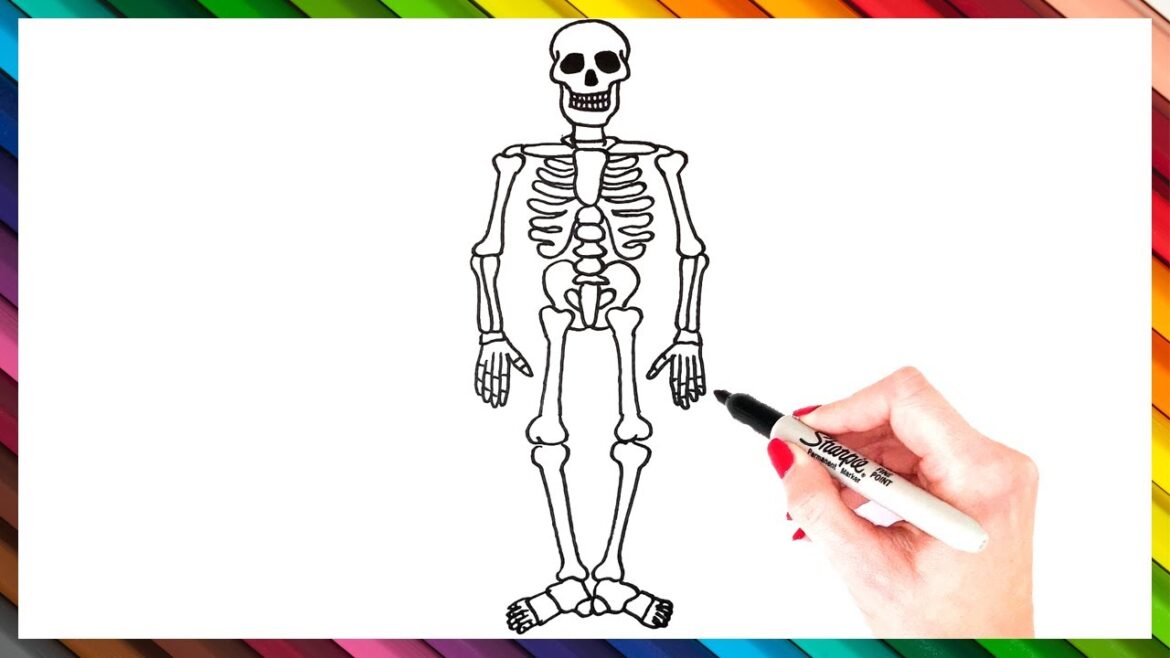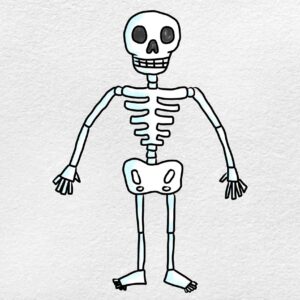
Drawing:9qs9xgbv4jo= skeleton has been a fundamental practice in art and science for centuries. From the detailed anatomical studies of Leonardo da Vinci to the imaginative depictions in contemporary pop culture, skeletons have served as both educational tools and sources of creative inspiration. This article delves into the significance of skeleton drawing, its historical context, and techniques to master this intricate art form.
Historical Context
Drawing:9qs9xgbv4jo= skeleton has deep roots in art history, closely tied to the study of anatomy. During the Renaissance, artists like Leonardo da Vinci and Andreas Vesalius meticulously studied and illustrated the human skeleton to understand the body’s structure and function better. These early works not only advanced medical knowledge but also elevated the standards of artistic realism.
In the 19th century, the rise of medical schools and institutions further popularized anatomical drawings. Artists were often employed to create detailed illustrations for textbooks and academic papers, making skeleton drawings a crucial component of medical education.
The Artistic Appeal
Drawing:9qs9xgbv4jo= skeleton possess a unique aesthetic that appeals to artists for various reasons. The interplay of bones, joints, and the overall structure offers a complex subject that challenges an artist’s understanding of form and proportion. Moreover, skeletons can be stylized in countless ways, from eerie and macabre to whimsical and fantastical, providing endless creative possibilities.
Drawing:9qs9xgbv4jo= skeleton are also symbolic. They can represent mortality, the passage of time, or the underlying structures that support life. This symbolic versatility makes them a powerful motif in both fine art and popular culture, appearing in works ranging from classical paintings to modern tattoos and digital art.
Techniques for Drawing Skeletons
Mastering the art of Drawing:9qs9xgbv4jo= skeleton requires a combination of anatomical knowledge and artistic skill. Here are some techniques to consider:
- Study Anatomy: A thorough understanding of human or animal anatomy is essential. Reference books, online courses, and anatomy models can be invaluable resources.
- Break Down the Structure: Start with basic shapes to outline the major bones and joints. This helps in establishing the correct proportions before adding details.
- Focus on Proportions: Pay close attention to the relative sizes and positions of different bones. Mistakes in proportion can make the skeleton look unrealistic.
- Detailing: Once the basic structure is in place, add details such as bone texture, joint connections, and any distinctive features. This step requires patience and precision.
- Shading and Lighting: Use shading to give the skeleton depth and dimension. Understanding how light interacts with the skeletal structure can enhance the realism of your drawing.
- Practice Different Poses: Drawing skeletons in various poses can help you understand how the bones move and interact. This is particularly useful for creating dynamic and lifelike illustrations.
Modern Applications
In contemporary art, Drawing:9qs9xgbv4jo= skeleton continue to captivate and inspire. Digital tools and software have opened new avenues for artists, allowing for more detailed and elaborate creations. Moreover, skeletons are a popular theme in genres such as fantasy, horror, and science fiction, often depicted in innovative and imaginative ways.
Educational institutions also continue to rely on skeleton drawings for teaching purposes. Advances in technology, such as 3D modeling and virtual reality, are complementing traditional drawing techniques, providing students with more immersive learning experiences.
Skeletons in Popular Culture
 Drawing:9qs9xgbv4jo= skeleton have transcended the realms of art and science to become iconic elements in popular culture. They frequently appear in movies, literature, and video games, often serving as symbols of fear, mystery, or the supernatural. For instance, the classic image of the grim reaper, a skeletal figure cloaked in black, has become synonymous with death. Similarly, pirates are often depicted with the Jolly Roger, a flag featuring a skull and crossbones, which signals danger and adventure.
Drawing:9qs9xgbv4jo= skeleton have transcended the realms of art and science to become iconic elements in popular culture. They frequently appear in movies, literature, and video games, often serving as symbols of fear, mystery, or the supernatural. For instance, the classic image of the grim reaper, a skeletal figure cloaked in black, has become synonymous with death. Similarly, pirates are often depicted with the Jolly Roger, a flag featuring a skull and crossbones, which signals danger and adventure.
In the world of animation and comics, skeletons are often anthropomorphized to create quirky, memorable characters. Think of Jack Drawing:9qs9xgbv4jo= skeleton from Tim Burton’s “The Nightmare Before Christmas,” whose skeletal form is both whimsical and gothic. These portrayals highlight the versatility of skeletons as a visual element that can convey a wide range of emotions and themes.
Skeletons in Day of the Dead Celebrations
One of the most culturally significant uses of skeleton imagery is seen in the Mexican celebration of Día de los Muertos (Day of the Dead). During this festival, Drawing:9qs9xgbv4jo= skeleton, often dressed in colorful attire and engaging in lively activities, are used to honor and remember deceased loved ones. These skeletons, known as calacas, are a joyful representation of the afterlife, emphasizing the cyclical nature of life and death.
Artists create intricate skeleton drawings and sculptures for the occasion, incorporating vibrant colors and elaborate designs. This festive approach to skeletons contrasts sharply with their often grim depictions in other cultures, showcasing the diversity of interpretation and meaning.
Skeletons in Contemporary Art
Contemporary artists continue to explore Drawing:9qs9xgbv4jo= skeleton as a subject, often using them to comment on social, political, or existential themes. For example, the works of artist Damien Hirst frequently feature skeletons and other anatomical elements to provoke thought about life, death, and the human condition. Similarly, street artists like Banksy have used skeleton imagery to make powerful statements about mortality and society.
The advent of digital art has also expanded the possibilities for skeleton drawings. Artists can now create hyper-realistic or highly stylized skeletons using digital tools, blending traditional techniques with modern technology. This fusion allows for greater experimentation and innovation, pushing the boundaries of how skeletons can be represented and perceived.
Educational Tools and Resources
For those interested in mastering Drawing:9qs9xgbv4jo= skeleton, a wealth of resources is available. Online platforms offer tutorials, workshops, and courses tailored to different skill levels. Anatomy apps and software provide interactive models that can be rotated and examined from multiple angles, aiding in the understanding of complex structures.
Art schools and universities often include skeleton drawing in their curriculum, emphasizing its importance in developing a comprehensive skill set. Students learn not only to draw but also to appreciate the anatomical accuracy and artistic expression that skeleton drawings can achieve.
Final Thoughts Drawing:9qs9xgbv4jo= skeleton
Drawing:9qs9xgbv4jo= skeleton is a practice that bridges art and science, creativity and precision. Whether for educational purposes, artistic exploration, or cultural expression, skeletons offer a unique subject that challenges and inspires. The keyword “drawing:9qs9xgbv4jo= skeleton” represents this multifaceted tradition, inviting artists to delve into the intricate world of bones and explore the myriad possibilities they present.
By embracing both historical techniques and modern innovations, artists can continue to evolve this timeless art form. Skeleton drawing is not just about depicting the human form; it is about understanding the underlying structures that make life possible and using that knowledge to create meaningful, impactful art.
Also Read: Drawing:5dlmdowxula= butterfly


